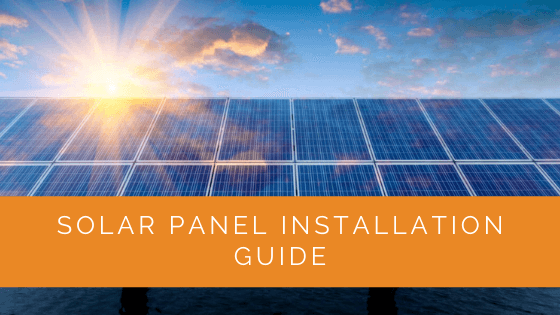Solar energy is, without a doubt, one of the most sustainable alternatives to grid-generated electricity. With solar electricity, you don’t just do your bit for the planet but also see a significant dip in your energy bills.
Installing a solar panel system might be a little pricey at first. Still, eventually, it gives great returns on your investment. Moreover, the process is quite straightforward and doesn’t require much involvement from you.
This solar installation guide will walk you through everything you need to know about how much solar panels cost and the process of installing solar panels.
Contents
- 1 Key Takeaways
- 2 Process of Installing Solar Panels
- 2.1 Find An Installer
- 2.2 Home Assessment
- 2.3 Erect The Scaffolding
- 2.4 Attach Roof Anchors
- 2.5 Attach The Frame
- 2.6 Install The Solar Panels
- 2.7 Wiring The Solar Panels
- 2.8 Series Connection
- 2.9 Parallel Connection
- 2.10 Connect To A Solar Inverter
- 2.11 Connect The Solar Inverter To The National Grid And A Solar Battery
- 2.12 Battery Storage Options
- 2.13 Start The Inverter
- 3 Solar Panel Costs
- 4 Factors Affecting The Cost Of Solar PV System
- 5 Financial Incentives
- 6 Case Study: Successful Solar Panel Installation for a Residential Client
- 7 Expert Insights From Our Solar Panel Installers About Solar Panel Installation
- 8 Discover the Power of Solar with Solar Panels Network
- 9 Closing Thoughts
Key Takeaways
- Solar panel installation offers a sustainable and cost-effective alternative to grid-generated electricity, with decreasing costs over the years.
- Installing solar panels involves finding an MCS-approved installer, conducting a home assessment, erecting scaffolding, attaching roof anchors and frames, and wiring the solar panels, among other steps.
- Factors affecting the cost of solar panel systems include the type of solar panels, the number of panels, installation complexity, labour costs, and additional components. Financial incentives like the Smart Export Guarantee (SEG) and Feed-in Tariff (FiT) can help homeowners earn money back when switching to renewable energy sources.
Process of Installing Solar Panels
The process of installing solar panels begins much before the physical installation. A lot of planning and decision-making is involved in solar panel installation.
Let’s go through the entire step-by-step process of installing solar panels.
Find An Installer
Firstly, you need to look for installers. In the UK, it is crucial to find an installer that is MCS-approved.
The Department of Energy and Climate Change supports the MCS certification. It ensures that the manufacturers and installers of solar energy or other sustainable energy sources conform to the highest quality and safety standards.
Home Assessment
Professional installers send teams to your home to assess the property. This team comprises a qualified surveyor and a salesperson to advise on the offerings.
You should reach out to multiple installers and get quotes from them after their assessment to compare the different offerings.
The physical work can begin once you choose the ideal installer for your needs.
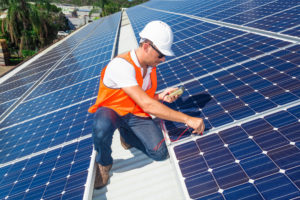
Erect The Scaffolding
Setting up scaffolding is an important step for the safety of the installation team. You need to ensure beforehand that there’s adequate space outside your house for erecting the scaffolding tower.
Attach Roof Anchors
Roof anchors are installed to hold the frame for fitting the solar panels. There are different roof anchors, and the type of roof tiles determines which one should be used.
The installers lift certain tiles from your roof and then attach the roof anchors to the rafters. They already checked the suitability of the roof and rafters during the home assessment.
Attach The Frame
The solar panel frame is fixed to the anchors running vertically and horizontally across the roof. The frame usually consists of aluminium bars locked into the anchors and screwed in place.
The installers ensure that each bar is straight and all of the bars run parallel.
Install The Solar Panels
Instead of being fitted to the roof, the panels are fixed loosely to the frame using an average of 4 clamps per solar panel. Then, they are tightened once the installing team correctly positions all panels.
During this step, the installers must be careful about the direction of the panels. In the northern hemisphere, solar panels should be installed south-facing for maximum sunlight.
Wiring The Solar Panels
The team will install electrical wiring once the solar panels are in place. Since MC4 connectors are suited for all panels, they are typically used for wiring.
Ensuring you shut down your domestic electricity supply during the wiring is important. The panels can be connected in two different connections: series and parallel.
Series Connection
In a series connection, a PV module’s positive wire is connected to another’s negative wire. Such an arrangement increases the voltage to match the battery bank.
Parallel Connection
In such a connection, the positive end of a module is connected to the positive and for another. Likewise, the negative wire of a module is connected to another negative end. In such an arrangement, the wiring voltage of the panel remains unchanged.
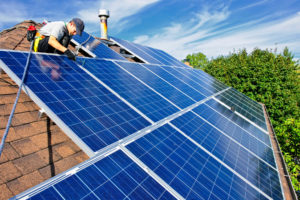
Connect To A Solar Inverter
After successful wiring, the installers connect the solar PV system to a solar inverter. For this purpose, the positive wire of the solar panel is connected to the negative terminal of the solar inverter.
Connect The Solar Inverter To The National Grid And A Solar Battery
You can start producing electricity once your solar inverter is connected to the National Grid and a solar battery.
To connect the inverter with the battery, the positive end of the battery is joined to the positive end of the solar inverter, and the same process is repeated for the negative ends.
The installers use a normal plug to connect the inverter and the grid to connect to the main power switchboard. Then, an output wire is connected to the electric board responsible for supplying electricity to the house.
Battery Storage Options
Battery storage systems are an integral component of modern solar panel installations. They allow homeowners to store excess solar energy generated during the day for use at night or during periods of low sunlight. This maximises the efficiency of a solar panel system and ensures a steady energy supply, reducing reliance on the National Grid.
Types of Solar Batteries:
- Lead-Acid Batteries: These are the most common and cost-effective options but have a shorter lifespan and lower depth of discharge compared to other types.
- Lithium-Ion Batteries: Known for their high energy density and efficiency, these batteries are lightweight, have a longer lifespan, and can handle deeper discharges.
- Flow Batteries: While not as common in residential settings due to their size and cost, flow batteries offer excellent scalability and long cycle life, making them suitable for larger installations.
Benefits of Solar Battery Storage:
- Energy Independence: With a battery storage system, you can use stored energy during peak times when electricity costs are higher or during power outages.
- Financial Savings: Storing excess energy allows you to avoid buying electricity at higher rates and can also increase earnings from schemes like the Smart Export Guarantee (SEG) by storing and exporting more energy when demand is high.
- Enhanced Energy Efficiency: By storing unused energy, batteries help reduce wastage and ensure that solar energy is used efficiently.
Start The Inverter
After all the steps are done, the installing team performs final checks and confirms everything is in place. You can then switch on the system and start using cleaner electricity!
Solar Panel Costs
Over the last few years, the cost of solar panels has decreased significantly with the revolution in solar energy technology.
While prices vary across brands and systems, we have outlined the estimated costs for different system sizes below.
- 3kW Panel System: £5,000 – £6,000
- 4kW Panel System: £6,000 – £8,000
- 5kW Panel System: £7,000 – £9,000
- 6kW Panel System: £8,000 – £10,000
These costs have been based on 250W panels and consider the national average household energy consumption to determine the average costs.
Besides the solar panel costs, you will also incur installation charges. The average solar panel installation cost is around £2,000 to £3,000. Additionally, you will have to invest in other devices, such as solar batteries.
Luckily, there are incentives available to households that use renewable energy sources. They are entitled to monetary benefits under schemes like the Feed-in Tariff or the Smart Export Guarantee.
Factors Affecting The Cost Of Solar PV System
Multiple factors come into play to determine the cost of installing solar panels.
Types Of Solar Panels
You will likely find one of three types of solar panels: monocrystalline, polycrystalline, and thin-film. The type of solar panel you select will affect the final price of your solar PV system.
Monocrystalline Solar Panels
These panels are made with monocrystalline solar cells and are the oldest solar panels. The cells used here are made of pure silicon and appear black because of the interaction between sunlight and silicon.
Polycrystalline Solar Panels
These panels consist of polycrystalline solar cells, a more recent development. They are also made of silicon and are pretty efficient.
Thin-Film Solar Panels
Thin-film solar panels are the latest entrants to the solar panel industry. They have become extremely famous to the credit of their panels, which are 350 times thinner than regular ones.
These solar panels are not always silicon and can be made of cadmium telluride or copper indium gallium selenide.
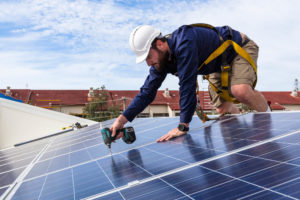
Number Of Panels
The number of panels in a solar PV system determines the system size. The larger your solar panel systems are, the more you’ll pay.
Solar Panel Installation Process
The ease of installation also impacts the cost of solar panel systems. The effort required varies depending on your roof’s size and strength, panels’ angling, and similar factors.
The higher the effort required for installing solar panels, the higher the installation cost.
Cost Of Labour
Your solar installation company may or may not include the labour costs in their quote detailing the solar panel costs. The cost of labour will vary based on your region.
Generally, it costs around £300 to £500 for a person each day of the project..
Additional Components of the Solar System
Your equipment cost rises if you install additional components to the solar panel system. Additional components could include a solar battery storage system or pigeon-proofing equipment.
It is better to club these costs during installation so that the overall cost of the process is reduced.
Financial Incentives
The United Kingdom is putting in conscious efforts to reduce carbon emissions. Earlier, the government offered financial incentives under the Feed-in Tariff (FiT). There are benefits under the Smart Export Guarantee (SEG) scheme.
The primary purpose of initiatives is to encourage homeowners to switch from fossil fuels to renewable energy sources, such as solar power, wind power, hydropower, and other options, to power their homes. While installing such systems, like a solar PV system, can be slightly expensive, these schemes help you earn your money back.
Although both incentives are similar, the SEG aims to replace the FiT. However, if you’re on the FiT program, moving to SEG before your term expires doesn’t make much sense.
Let us learn more about both of the incentives.
Smart Export Guarantee (SEG)
The SEG is a government-backed incentive that provides export tariffs for small-scale, low-carbon energy generation to UK homeowners. You can leverage the scheme for various energy sources, such as solar and wind energy.
Under the incentive, you receive an export tariff for the excess renewable energy you generate and export to the National Grid. If unused solar energy goes into solar battery storage, even that is covered under the SEG in some cases.
Remember that you only get paid for the amount of energy you export back to the grid. You can receive a fixed rate or a rate that fluctuates based on demand and supply.
If you want to hop on to the SEG, you must first ensure that your solar panel system is MCS certified and then look for an SEG licensee. You even need a smart export meter that sends half-hourly readings to the licensee.
However, you are not eligible to receive the SEG export tariff if you already receive the FiT payments.
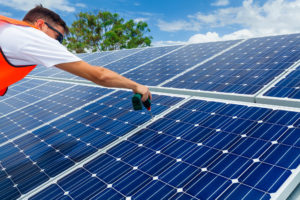
Feed-in Tariff (FiT)
The UK government introduced the FiT scheme in 2010 to encourage renewable, low-carbon energy generation in domestic settings. Much like SEG, this incentive also covered multiple sources of renewable energy. However, the initiative closed for new applicants in early 2019.
The FiT includes two components: a generation tariff and an export tariff. The generation tariff is the amount paid to the homeowners for the total electricity generated. This amount is calculated on a per-unit basis.
The export tariff is the amount paid for units of electricity exported back to the grid. However, it does not depend on the actual amount of electricity you export. Instead, the number of units is automatically assumed to be 50% of the total amount generated by your system.
The tariff is payable for up to 20 years and is typically paid quarter by quarter. The best part, perhaps, is that these payments are tax-free.
People prefer staying on the FiT over the SEG. It happens because the SEG only pays you for the electricity exported. At the same time, the FiT automatically assumes the export to be half of the total energy produced.
Case Study: Successful Solar Panel Installation for a Residential Client
Background
At Solar Panels Network, we often encounter homeowners eager to transition to renewable energy but uncertain about the installation process and potential costs. This case study focuses on a recent project where we installed a solar PV system for a residential client seeking to reduce their electricity bills and environmental footprint.
Project Overview
The homeowner, a family of four, expressed interest in solar energy to offset rising electricity costs and take advantage of government incentives like the Smart Export Guarantee (SEG). They wanted a reliable system that would provide a substantial portion of their household’s energy needs. The main challenge was to design and install a system within their budget while maximizing efficiency.
Implementation
- Initial Consultation and Site Assessment: We began with a detailed consultation to understand the client’s energy consumption patterns and goals. Our team conducted a comprehensive site assessment, examining the roof’s orientation, shading factors, and structural integrity to determine the optimal placement and type of solar panels.
- System Design and Selection: Based on the assessment, we recommended a 4kW monocrystalline solar panel system, known for its high efficiency and durability. The system design included 16 panels arranged to maximize sunlight capture, considering the property’s southern exposure.
- Installation Process: Our certified team erected scaffolding for safety, attached roof anchors, and installed the aluminium frame to hold the panels. The solar panels were securely mounted and wired, and we connected the system to a solar inverter. Additionally, we set up a solar battery storage unit to store excess energy, enhancing the system’s efficiency and reliability.
- Connection and Testing: After installation, we connected the system to the National Grid and performed rigorous testing to ensure optimal performance. We also installed a smart meter to monitor energy production and consumption, providing the client with real-time data.
Results
- Energy Production and Savings: The system has performed exceptionally well, producing approximately 70% of the household’s energy needs. The client has seen a noticeable reduction in electricity bills, particularly during peak sunshine months.
- Environmental Impact: The installation has significantly reduced the household’s carbon footprint, aligning with their commitment to sustainability. The family has also taken advantage of the SEG, earning credits for excess energy exported back to the grid.
- Customer Satisfaction: The homeowner was pleased with the professional service and clear communication throughout the process. The solar battery system provided an additional layer of security and savings, storing excess energy for use during peak demand times.
Summary
This case study illustrates the benefits of residential solar panel installation, from financial savings to environmental impact. By choosing the right system and installer, the client successfully transitioned to renewable energy, significantly reducing their reliance on traditional electricity sources. At Solar Panels Network, we pride ourselves on delivering tailored solar solutions that meet our clients’ unique needs, ensuring a smooth and rewarding transition to solar power.
Expert Insights From Our Solar Panel Installers About Solar Panel Installation
Proper installation is key to maximizing the efficiency and longevity of solar panels. Ensuring that panels are correctly angled and securely mounted not only optimizes energy capture but also protects your investment against harsh weather conditions.
Senior Solar Technician
Choosing the right installer can make all the difference. It’s crucial to work with MCS-approved installers who follow stringent safety and quality standards. This certification provides peace of mind and guarantees a high-quality installation.
Lead Installation Specialist
Installing solar panels isn’t just about placing them on your roof; it’s about integrating a system that meets your energy needs and maximizes your return on investment. We guide our clients through every step, from selecting the right panels to navigating financial incentives.
Renewable Energy Consultant
Discover the Power of Solar with Solar Panels Network
Are you navigating the world of solar installations? Look no further than Solar Panels Network, the UK’s trusted partner in harnessing the sun’s potential. Our dedication goes beyond just installations; we’re on a mission to transform how homeowners and businesses across the UK perceive and utilise energy. By choosing us, you’re reducing your carbon footprint and making a smart financial move that promises savings for years ahead. Contact us today and embark on your solar journey.
Closing Thoughts
The number of people switching to clean energy sources, such as solar power, increases daily. As an increasing chunk of the population debates whether they should make the switch, there are bound to be questions about the installation process and panel costs.
In this guide, we have tried to address all the information necessary for deciding on installing solar panels in your home, along with the estimated costs.
It is best to remember that while the one-time process may be pricey, it pays for itself in the long run!
About the Author
Solar Panels Network stands at the forefront of solar energy solutions, driven by a team of seasoned solar engineers and energy consultants. With over decades of experience in delivering high-quality solar installations and maintenance, we are committed to promoting sustainable energy through customer-centric, tailored solutions. Our articles reflect this commitment, crafted collaboratively by experts to provide accurate, up-to-date insights into solar technology, ensuring our readers are well-informed and empowered in their solar energy decisions.

